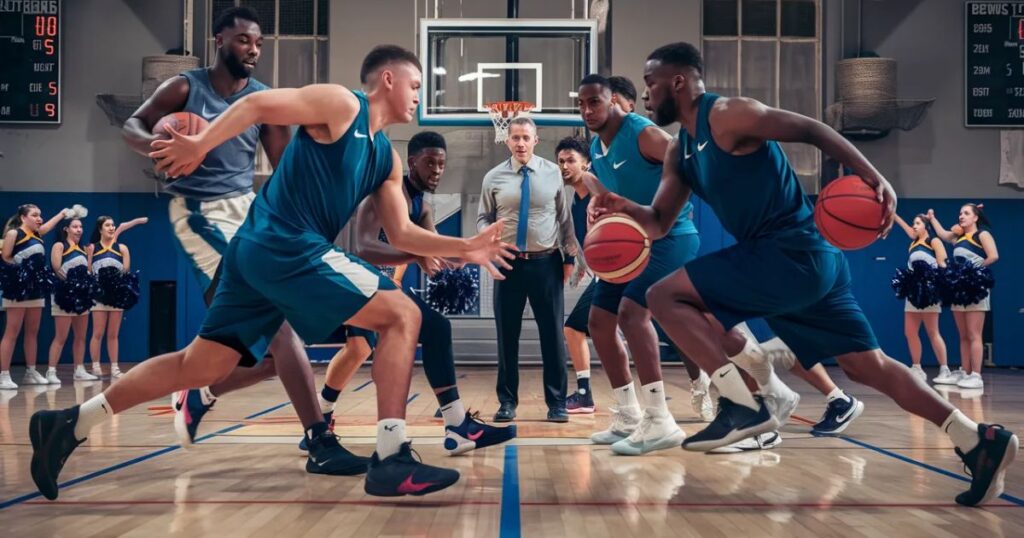In the world of basketball, practice makes perfect. Even the most dedicated players and coaches know that drills and individual skill work alone aren’t enough to truly prepare for the intensity and unpredictability of real games.
That’s where scrimmages come in – the invaluable practice games that allow teams to put their training to the test in a simulation of an actual competitive environment.
As NBA legend Kobe Bryant once said, If your job is to try to be the best basketball player you can be, you have to practice, you have to train.
Scrimmages are a crucial part of that training process, providing live reps and mock games that mimic the speed, pressure, and flow of official matches.
In this comprehensive guide, we’ll dive deep into the concept of basketball scrimmages, exploring their basics, benefits, organization tips, and frequently asked questions.
Basics of a Basketball Scrimmage
At its core, a basketball scrimmage is a practice game where players experience realistic game conditions without the full weight and pressure of an official match.
These scrimmages play a vital role in preparing players and teams for the regular season by allowing them to put into practice the skills, plays, sets, and formations they’ve learned in a full-game setting.
While individual drills and half-court sets are essential for building fundamentals, scrimmages offer a unique opportunity to test and refine a team’s strategies, tactics, and game plans against live opposition.
It’s a chance to work on teamwork, communication, and coordination in a controlled yet competitive environment.
Defining a Scrimmage in Basketball: More Than Just a Practice Game

While scrimmages in basketball are practice games, they are set up to simulate a real game as closely as possible. This typically involves:
- Two teams playing against each other
- Referees to call the game
- Staff to keep score and operate the game clock
The key difference between a scrimmage and an official game is that the scrimmage results don’t count towards any team’s record or league/tournament standings. Player stats like points, assists, and rebounds are also not officially recorded.
This unique setup allows players to master their team’s offensive and defensive schemes while also providing a safe space to try out new strategies, skills, and approaches without the high-stakes pressure of a real game. It’s a valuable opportunity for trial-and-error and growth.
Read More : Understanding Hand Checking in Basketball: A Guide to the Rule, Impact, and Debates
Two Types of Scrimmages
In basketball, scrimmages generally fall into two main categories: intrasquad and opposing team scrimmages.
Intrasquad Scrimmages
An intrasquad scrimmage involves players from the same team splitting into two groups to play against each other in a mock game scenario. This type of scrimmage offers several key advantages:
- Safe Environment: Players can experiment with new positions, strategies, or skills without the pressure of performing in front of an external opponent.
- Familiarity: By scrimmaging against teammates they know well, players can better understand each other’s playing styles and tendencies.
- Team Building: Intrasquad scrimmages help strengthen team bonds, improve communication, and foster a sense of camaraderie among players.
Opposing Team Scrimmages
On the other hand, opposing team scrimmages are set up against a different team, simulating a more authentic competitive match. These scrimmages offer their own unique benefits:
- New Challenges: Facing an unfamiliar opponent brings new playing styles, strategies, and challenges, providing a broader learning experience for players and coaches.
- Real-Game Feel: Playing against an external team more closely mimics the intensity and unpredictability of an actual competitive match, giving players and coaches a better gauge of their readiness for the upcoming season.
- Adaptability Practice: Opposing team scrimmages encourage players and coaches to handle unexpected situations, improving their ability to adapt and make in-game adjustments during real competitions.
Both types of scrimmages play a crucial role in a team’s overall preparation and development, offering different learning opportunities and challenges.
Benefits of Scrimmage in Basketball Training

Scrimmages are more than just practice games – they are invaluable tools for growth, evaluation, and preparation.
During scrimmages, coaches can observe their players’ real progress and see how they respond to various game situations, allowing for targeted feedback and coaching adjustments.
For players, scrimmages provide a unique opportunity to:
- Improve Instincts and Creativity: With the freedom to experiment without the pressure of an official game, players can hone their split-second decision-making abilities and explore new creative moves or plays.
- Connect Skills to Game Situations: After countless hours of drilling individual skills and set plays, scrimmages allow players to apply those techniques in a dynamic, live game environment.
- Enhance the Feedback Process: Scrimmages facilitate open communication between coaches and players, helping both parties better understand expectations and learn how to effectively communicate during timeouts, stoppages, and in-game situations.
- Adapt to Game Speed: While practice drills are valuable, they often don’t replicate the true pace and intensity of a competitive game. Scrimmages help players adjust to the tempo and full-speed nature of real matches.
- Solidify Understanding of Systems: Running through offensive schemes or defensive formations at game speed against live opposition helps players truly grasp and internalize a team’s overall systems and philosophies.
- Improve Conditioning and Fitness: The physical demands of a scrimmage, including the constant movement, quick transitions, and extended playing time, can help players build the endurance and conditioning needed for the rigors of a full season.
For coaches, scrimmages offer a unique opportunity to:
- Evaluate what offensive and defensive tactics are working (or not working) against real opposition
- Identify areas for improvement or adjustments in team coordination, rotations, and overall preparedness
- Experiment with different lineups, substitution patterns, and role assignments
- Conduct in-game coaching and analysis to better prepare for the regular season
Ultimately, scrimmages are a invaluable tool for player and team growth, improvement, mastery, and preparation, providing a bridge between practice and the intense realities of official competition.
How to Organize a Quality Basketball Scrimmage
Organizing an effective basketball scrimmage requires careful planning and attention to detail to create an environment that truly simulates a real game.
The goal is to make the scrimmage as authentic and game-like as possible, allowing players and coaches to practice and prepare in the most realistic conditions possible.
Here are 10 essential tips for setting up a high-quality basketball scrimmage:
- Schedule Scrimmages Before Official Games: Plan scrimmages in the weeks leading up to the start of the regular season. This helps players get into the rhythm and mindset of real games while still having time to make adjustments based on scrimmage performance.
- Scrimmage Against Another Squad (When Possible): While intrasquad scrimmages have their benefits, scrimmaging against an opposing team provides new challenges and learning opportunities that better simulate the unpredictability of real competition.
- Play 5-on-5 with Regular Rules: Use standard game rules and play full 5-on-5 to maintain the authentic feel of a real game. This helps players adjust to official rules, court dimensions, and game flow.
- Have Staff to Keep Score and Run the Clock: Just like in real games, designate staff members to keep the official score and manage the game clock. This adds an extra layer of realism and competitive intensity.
- Hire Referees (If Possible): If feasible, bring in professional or experienced referees to officiate the scrimmage. This helps players adapt to official calls, learn to avoid fouls and violations, and better understand the nuances of the rules.
- Use Your Pre-Game Routine: Start the scrimmage with your regular pre-game meetings, warm-ups, and preparation routines. This sets the tone and gets players mentally and physically ready, just as they would for an official game.
- Scrimmage in Game-Length Periods: Match the duration of the scrimmage to that of a real game, divided into quarters or halves. This tests players’ endurance and prepares them for the ebb and flow of a full competitive match.
- Get Everyone in the Scrimmage: Rotate all players throughout the scrimmage, giving everyone valuable game-like experience. This can also help coaches identify the best combinations and rotations for the upcoming season.
- Schedule Post-Scrimmage Practice Situations: After the official scrimmage, consider setting aside time to work on specific game situations, such as out-of-bounds plays, late-game scenarios, or high-pressure situations.
- Film the Scrimmage: Record the scrimmage, if possible. Watching the film afterward can be an invaluable tool for analyzing players’ performance, evaluating strategies, and identifying areas for improvement.
By following these tips, coaches can create a scrimmage environment that closely mirrors the intensity, pressure, and realism of an official game, providing players with an invaluable opportunity to put their skills and preparation to the test.
FAQs
What does a scrimmage mean in basketball?
A basketball scrimmage is a practice game designed to simulate a real game. It’s used for training purposes, allowing players to experience game-like conditions without the pressure of an official match’s outcome.
What is the difference between a game and a scrimmage?
The main distinction between a game and a scrimmage is the stakes involved. An official game counts towards a team’s record or standing in a league or tournament, while a scrimmage is purely for practice and preparation.
What is the point of a scrimmage game?
The primary purpose of a scrimmage in basketball is to provide players with a simulation of a real game in a controlled, practice setting.
Does scrimmaging count as a game?
No, scrimmaging does not count as an official game. Scrimmages are strictly for practice, evaluation, preparation, and development purposes, and their results have no impact on a team’s official record or standing.
Conclusion
In the world of basketball, scrimmages are an essential component of any team’s training and preparation process.
These practice games provide a unique opportunity for players and coaches to simulate the intensity, pressure, and unpredictability of real competition in a controlled environment.
By understanding the basics of scrimmages, their benefits, and how to organize effective ones, teams at all levels can take their skills, strategies, and teamwork to new heights.
From improving individual instincts and creativity to solidifying a team’s understanding of its offensive and defensive systems, scrimmages offer an invaluable bridge between practice and the realities of official games.



